- Home
- Staff
- Faculty
- Human Resources
- Student
- Quick Links
- Library
- AUAmed.org
- AUA Research Council
- AUA Campus Newsletter
- Covid-19 Safety Training
- Campus & Home Safety
- Continuous Quality Improvement
- Disaster Preparedness
- Digital Signage
- Email Login
- Fitness Center
- Healthy Perspectives
- Maintenance Requests
- Orange HRM
- University Wellness Center
- Wellness and Inclusion


